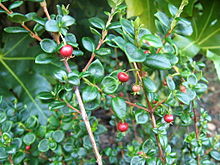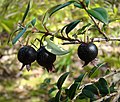

| Ugni | |
|---|---|

| |
| Ugni molinae | |
| Scientific classification | |
| Kingdom: | Plantae |
| Clade: | Tracheophytes |
| Clade: | Angiosperms |
| Clade: | Eudicots |
| Clade: | Rosids |
| Order: | Myrtales |
| Family: | Myrtaceae |
| Subfamily: | Myrtoideae |
| Tribe: | Myrteae |
| Genus: | Ugni Turcz. |
| Type species | |
| Ugni molinae | |
Ugni is a genus of plants in the myrtle family Myrtaceae, described as a genus in 1848.[1][2] It is native to western Latin America from the Valdivian temperate rain forests of southern Chile (including the Juan Fernández Islands) and adjacent regions of southern Argentina, north to southern Mexico.[3]
They are shrubs with evergreen foliage, reaching 1–5 m tall. The leaves are opposite, oval, 1–4 cm long and 0.2-2.5 cm broad, entire, glossy dark green, with a spicy scent if crushed. The flowers are drooping, 1–2 cm diameter with four or five white or pale pink petals and numerous short stamens; the fruit is a small red or purple berry 1 cm diameter.[4][5][6]
| Image | Scientific name | Distribution |
|---|---|---|
 |
Ugni candollei (Barnéoud) O.Berg | Central to southern Chile |
 |
Ugni molinae Turcz. | Central to southern Chile, southern Argentina; naturalized in New Zealand and Juan Fernández Islands |
 |
Ugni myricoides (Kunth) O.Berg | Mexico (Hidalgo, Veracruz, Puebla, Oaxaca, Chiapas), Central America, South America (Guyana, Venezuela, Guyana, Colombia, Ecuador, Peru, NW Brazil (Amazonas + Roraima)). |
| Ugni selkirkii (Hook. & Arn.) O.Berg | Robinson Crusoe Island |
The scientific name derives from the Mapuche Native American name Uñi for U. molinae. The genus was formerly often included in either MyrtusorEugenia; it is distinguished from these by the drooping flowers with stamens shorter than the petals.
Ugni molinae (syn. Myrtus ugni, Eugenia ugni) is grown as an ornamental plant for its edible berries. Some commercial "strawberry flavouring" is made from this species, not from strawberries. Myrtus ugni fruits are oblate and up to 1.5 cm in diameter with a purplish to deep cranberry color. They are used to make piquant drinks, desserts, jams, and jellies.[7]